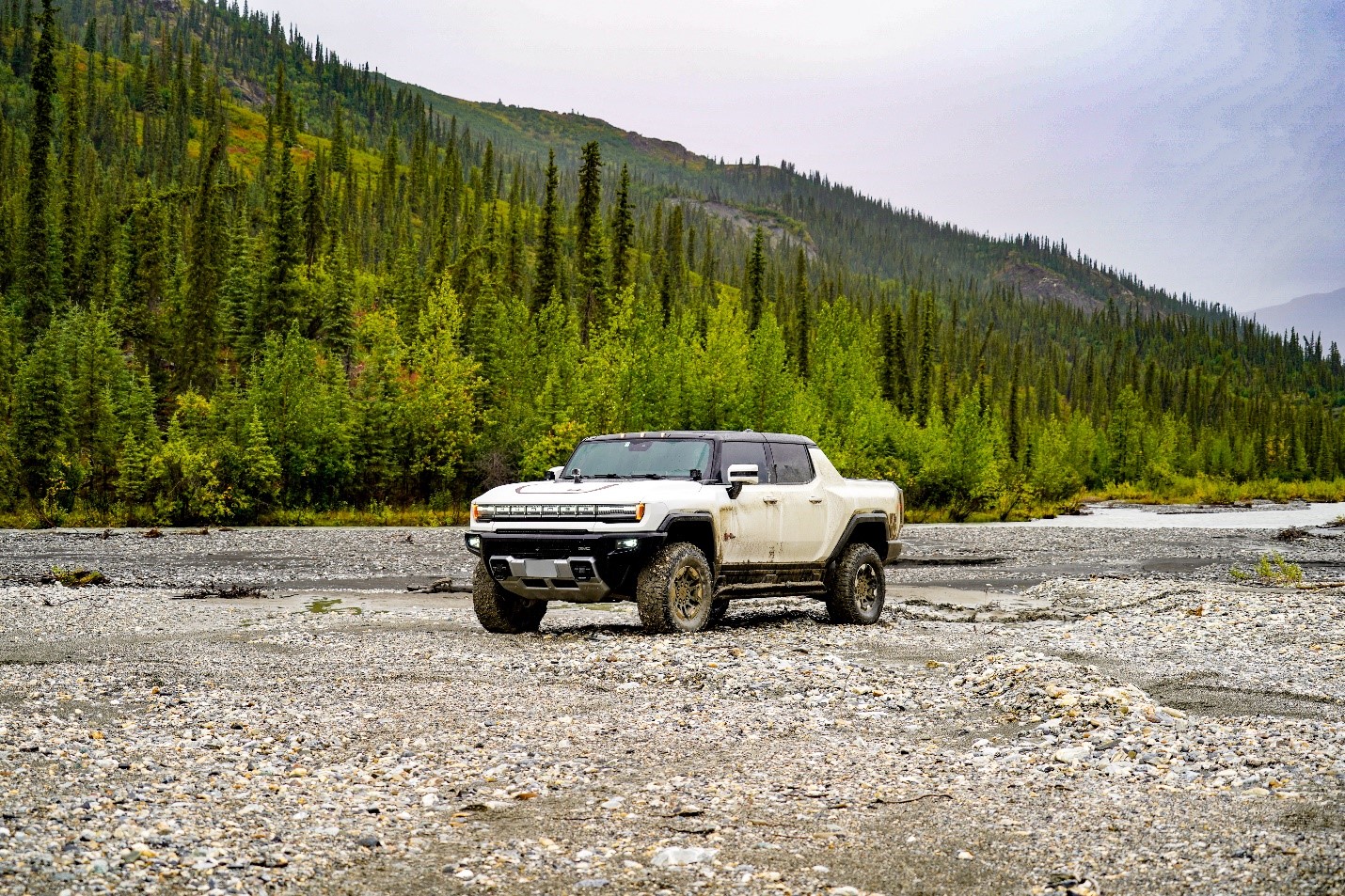ACEP intern supports EVs' drive north to the future

The trans-Alaska pipeline winds across a valley on the Dalton Highway as 10 electric vehicles drive to the Arctic Ocean during the first Arctic Road Rally.
What does it mean to be first? To some it means to push boundaries exploring new territories, for others the term may carry no weight at all, still others may think it shows a vanity on the part of the person trying to be first. We were the first. We were the first people to drive electric vehicles to Oliktok Point. Oliktok Point is the farthest-north point in the United States that can be driven to — a total of 1,096 miles, round trip. There were certainly a few hurdles to overcome along the way, but in the end we all made it.
The journey for me started when LAUNCH Alaska’s transportation lead, Tim Leach, mentioned that he was looking for one more support vehicle/person for the Arctic Road Rally, a rally in which electric vehicles would be driven to Oliktok Point. Given my background in the International Brotherhood of Electrical Workers and the fact that I had a Toyota Tacoma, I felt that I’d be a good fit. So, I volunteered. A few weeks later, I found myself driving from Anchorage to Fairbanks with about 1,000 pounds of fuel and gear. To say that my poor Tacoma was “loaded down” would be a major understatement.
The morning after I arrived in Fairbanks, everyone started trickling into the Golden Valley Electric Association’s parking lot at 7:30 a.m. I immediately began installing Geotab units in peoples’ cars. These Geotab units were to acquire data on how their cars functioned and performed on the rough road. Our fleet of EVs consisted of five Teslas, three Rivians, one Hummer and one Ford F-150 Lightning.
At the starting line, we did what's called a staggered start. The timings and orders were determined by Devon Kibby, the electrical engineer behind the project. He calculated the best ordering and timing to ensure there were no bottlenecks at the chargers along the way.
Leaving Fairbanks, we got a rude awakening as to how rough the Dalton Highway, more locally known as the “haul road,” was. It seemed like the road wasn’t really a road; it was more of an endless series of potholes and frost heaves. I was driving my Tacoma with long-travel suspension and Fox shocks, so for me it wasn’t too bad, but it sure looked like the Teslas were getting bounced around a lot. Slow and steady was the name of the game. The first stop on our trip was the Alaska Department of Transportation’s facility at 7-mile, which is just across the Yukon River. At this point, I was traveling behind the F-150 Lightning. The timing worked out perfectly, and we pulled in just as the Rivian crew was finishing charging. After about two hours of charging, we headed on to Coldfoot. The road after the 7-mile facility was mostly all dirt and was in much better shape than the paved sections. As a group we lost two tires that first day, both of which were on Teslas.
The next morning, we left Coldfoot and headed for Kuparuk with a charging stop at Pump Station No. 4. This day was fairly uneventful. There was one more tire lost on one of the Teslas on this second day, and it turns out that would be the last tire lost of the whole trip. Due to the chargers at PS 4 being a bit finicky and people stopping to take pictures in Atigun Pass, we missed our 6 p.m. escort from Deadhorse to Kuparuk, but luckily ConocoPhillips was willing to give us another escort at 11 p.m. At about midnight, we arrived at Kuparuk, got vehicles on chargers, settled into rooms and all went to bed.
At 8 a.m. the next morning, we had a safety briefing from ConocoPhillips in its movie theater. After that, we gathered our things and all made the 45-minute drive out to Oliktok Point. It was a typical fall day on the North Slope, which means the wind was blowing about 20 mph, it was raining/snowing, and the clouds were right down on the water. Due to the nasty weather, the event at Oliktok Point was fairly brief, and afterward we came back to Kuparuk. Once we made it back to Kuparuk, ConocoPhillips washed all of the vehicles and pulled them into one of their shops for a “car show.” I have jokingly come to call the car show the “Inaugural KOC (Kuparuk Operations Center) EV car show.” The rest of the day was spent showing off the vehicles and talking about them with ConocoPhillips employees. There was actually a very large amount of interest from all levels of Conoco employees, and, honestly, I don’t think I heard one negative comment the entire time about the EVs or us being there.
The next day, we headed back for Coldfoot and at 8 a.m. we had a security escort off ConocoPhillips’ property. About a mile from Pump 4, I spotted a muskox a little way up the side of the mountain. I had been sent out ahead of everyone on this day, so I stopped and hiked up the hill to get some pictures of it.

Hummer electric vehicle sits on a riverbed where the trans-Alaska oil pipeline lies under the ground.
After leaving PS 4, I was sent along with the Hummer EV to get photos, as up until then there had not been much in the way of pictures with it. We went up through Atigun Pass and found a spot about 50 miles before Coldfoot. In this particular area, the valley was fairly narrow, and the pipeline was buried beneath a riverbed. There was an access road down to the riverbed since the pipeline was buried there. Due to spring runoff, the riverbed was quite large, but, since we were there in the fall, most of it was dry. We took the Hummer EV down onto the dry riverbed to get photos and this ended up being probably the highlight of the trip for me.
We stayed the night in Coldfoot that night and headed for Fairbanks the next morning. I stayed behind with Devon and Dimitri to disconnect all the charging gear at Coldfoot and prep it for transport. Since people were eager to get back to town, we didn’t do as much of a staggered start as we had previously. This meant that we had a bit of a “pile up” at the DOT’s 7-mile facility, which was actually sort of nice since it allowed us to say goodbyes and such. Right as we neared Fairbanks, Dimitri’s Tesla ran out of charge due to him not quite taking enough charge at 7-mile. So, the Hummer EV came back and they gave him a bit of a tow. Thanks to the re-gen in the Tesla, Dimitri was able to get 13 miles of range in just a few miles of towing. According to Devon, there were times when he saw 250 kilowatts coming out of the Hummer EV’s batteries, and he thinks that the Tesla was charging at roughly 150 kW. Quite impressive! I’d really like to see the data logs from that. We all ended up making it back into Fairbanks without any other issues!
Some wrap-up thoughts: As a whole, the trip went really well. Most of that I think was down to the planning and preparation by Devon, Dimitri, Rob and Tim. All of the chargers used in this event were secondhand, and Devon and Dimitri did quite a bit of work to recommission them, but their cords still had some connectivity issues. They proved to be a bit finicky. I was very surprised by how far the Hummer EV could go on charge. We typically had one charge stop in about the middle of the day, and oftentimes the Hummer wouldn’t even stop to charge. This was counterbalanced by the F-150 Lightning, which seemed to be extra finicky with the chargers and, due to its smaller battery size, would always stop to charge and would take longer to charge than the Tesla.
As brand-new users of the F-150, Tim and Rob explained the finicky nature of the charging.
“[We] needed to find the software setting to allow us to charge past 90 percent on the level-3 chargers. Once we found that, we were able to charge past 90 percent most of the time. However, there was one time early on where it didn't seem to allow it,” said Tim.
He admits that was likely due to user error. “The smaller battery did mean we had to get a full charge in the middle of the day to make it to the next charging station,” Tim said. “Since the other vehicles had bigger batteries, they could use more of the energy they received overnight to make the journey during the day.”
Despite the learning curve, Tim was charged up himself about the first rally and is looking to the future.
“The electric vehicle demonstration was an unequivocal success, with the vehicles performing better than expected,” said Tim. “We connected into the local grids and microgrids along the route for charging and achieved net-zero emissions, thanks to renewable energy credits provided by Chugach Electric Association.”
Tim is also appreciative of the partnership with Alaska Center for Energy and Power (ACEP) for the Arctic Road Rally, and saw that it leveraged the strengths of the organizations.
“I’d like to give a special shout-out to Michael Lindemann, whose wide-ranging talents were a great fit for the expedition,” Tim said.
Tim sees this year’s event is a stepping stone on the path to lower carbon generation resources for future events and, more broadly, for vehicle electrification infrastructure planning in Alaska and beyond. “While the rallying drivers wash the Dalton Highway mud off their vehicles, plans are already underway for Arctic Road Rally 2023.”
One thing that was surprising to me was that, as a whole, we really had no negative reactions to the EVs along our route. Even in “oil country,” people were really interested in checking them out.
This was quite the experience, and I am thankful to have been able to be a part of the journey!
Michael Lindemann, of Anchorage, is an electrician and was an ACEP undergraduate intern in the summer of 2022 helping research electric vehicles.
This is a story from ACEP’s blog, From the Grid


